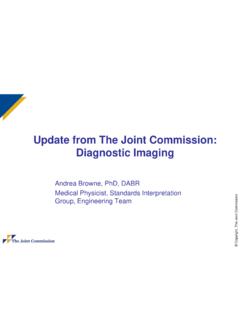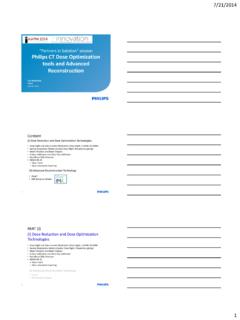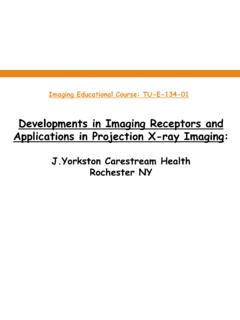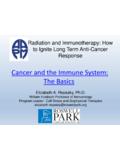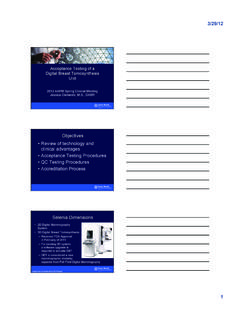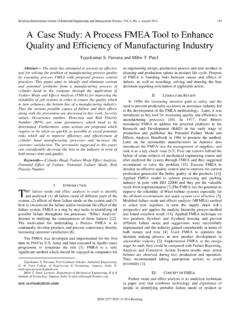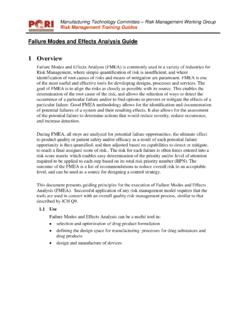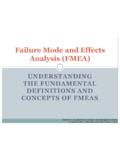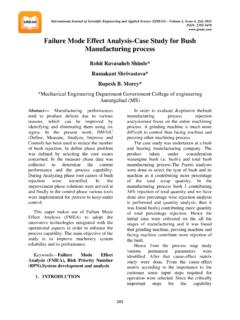Transcription of Hands-on FMEA - AMOS Online
1 Hands-on FMEA Jennifer L Johnson, MS, MBA 2014 AAPM Spring Clinical Meeting Denver, CO Outline Introduction our responsibilities FMEA Specifics Example Clinical examples Emergency treatments DIBH breast Breakout session Feedback Getting started at home Wrap up Learning Objectives By the end of this session, the participant will be able to 1) Describe process failure mode and effects analysis (FMEA) concepts. 2) Apply FMEA on a single process step in a 2D case. (AAPM, 2009) What Are Our Responsibilities? (Klein et. al., 2009) What Are Our Responsibilities? (Hendee and Herman, 2010) What Are Our Responsibilities? What Are Our Responsibilities? The application of radiation to the human body entails risk..Medical the safety and effectiveness of radiological procedures by verifying the appropriate type, dosage, and application of radiation to the body. (LaPointe, Summer 2011) Complexity and Risk Explosion Need a formal, structured way to approach risk V M AT 3D-CRT MLC IGRT CBCT IMRT SBRT DIBH EDW GATING Tomotherapy FFF SRS HDR Cyberknife failure Mode and Effects Analysis (FMEA) Systematic, proactive approach for identifying possible failures in a design, process or service Failures = any errors, either potential or actual failure modes = ways in which something might fail Effects analysis = studying the consequences of those failures Reduce the risk of harm by proactively correcting the processes to prevent the failures failure Mode and Effects Analysis (FMEA) Focus on the highest risk failure modes failure modes prioritized based on how Frequently they occur (O), Easily they can be undetected (D), and Severe (S) are the consequences Scale each 1 (low) 10 (high).
2 Alternatively 1 3 or 1 5 failure Mode and Effects Analysis (FMEA) (Thomadsen et. al., 2013) failure Mode and Effects Analysis (FMEA) (Ford et. al., 2009) failure Mode and Effects Analysis (FMEA) Calculate risk priority number (RPN) = O*D*S Higher RPN means failure mode is more likely to occur, be undetected, have greater severity Range 1 to 1000 Alternatively 1 to 27 or 1 to 125 Rank RPN Plan improvements Using FMEA Plan actions to reduce harm from failure modes Likely to Occur Eliminate any or all causes Add a forcing function making it impossible Add verification step ( , double check, bar codes, alert screens)? Modify other contributing processes Likely to be unDetected Identify prior events that can serve as flag of the failure mode Add a step to intervene Technological alerts when values approach unsafe limits (Institute for Healthcare Improvement, 2004) Using FMEA Likely to cause Severe harm Identify early warning signs and train staff to recognize them Provide information and resources at points of care for events Evaluate potential impact of considered changes Monitor and track improvement over time (Institute for Healthcare Improvement, 2004) Steps to Completing FMEA Select a Process Recruit a Multidisciplinary Te a m Determine All Process Steps List failure Modes and Causes Assign Numeric Values for Occurrence, Detection, and Severity Evaluate Results Use RPNs to Plan Improvement Efforts (Institute for Healthcare Improvement, 2004)
3 FMEA Form ATM Example Insert Card Enter PIN Request Cash Collect Cash Retrieve Card End Process map for ATM Cash Machine Bank s view: High risk of collecting cash then leaving card in machine (Cost $$$ to replace) What to do to minimize the risk? ATM Example Insert Card Enter PIN Request Cash Retrieve Card Collect Cash End Process map for ATM Cash Machine Your turn: Risk of failure of inserting card What could be the failure modes? ATM Example failure Modes Insert Card Not insert card Insert card wrong direction Insert wrong card (debit vs. credit) For each, what could be the Causes? Effects? Likelihood of Occurrence? Detectability? Severity? What to do to minimize the risk? ATM Example failure Modes What to do to minimize the risk? ATM Example Insert Card Enter PIN Request Cash Retrieve Card Collect Cash End Your turn: High risk of requested cash amount is incorrect What could be the failure modes?
4 ATM Example failure Modes Request Cash Not enough Too much Typo For each, what could be the Causes? Effects? Likelihood of Occurrence? Detectability? Severity? What to do to minimize the risk? ATM Example failure Modes Radiation Therapy Process Examples TG-100 IMRT and HDR brachytherapy (Huq , 2008) QA for dynamic MLC tracking systems (Sawant et. al., 2010) Delivery of Lung SBRT (Perks et. al., 2012) Intraoperative RT using mobile electron linear accelerators (Ciocca et. al., 2012) Pretreatment phases in Tomotherapy (Broggi et. al., 2013) HDR brachytherapy treatment planning (Wilkinson and Kolar, 2013) Scanned proton beam radiotherapy treatment planning (Cantone et. al., 2013) (Ford et. al., 2011) Breakout T-Spine Example Problem: palliative spine treatment Prescription: Site: T6, so field covers T5 T7 Technique: AP/PA Energy: 18 MV Dose: 4 Gy / fraction Field size: 8 x 10 (width x length) SAD setup, AP/PA separation 20 cm Breakout T-Spine Example Using a part of the Process Map, pick a few subprocesses and calculate the RPN score Radiation Treatment Process Map Patient Assessment Imaging for RT Planning Treatment Planning Pretreatment Review / Verification Treatment Delivery On-Treatment Quality Management Post-Treatment Completion (Ford et.)
5 Al., 2012) Radiation Treatment Process Map Treatment Planning Isocenter definition Dose distribution optimization Dose distribution calculation Preliminary evaluation of treatment plan by physician Preliminary evaluation of treatment plan by physics Iteration of treatment plan Set up for image-guidance Final plan and prescription approval by physician Plan information transfer to radiation oncology information system Scheduling treatment session(s) Pretreatment Review / Verification Physics plan review Independent dose calculation Plan data transfer to treatment unit Verification of parameters at treatment unit Physics verification / approval Therapists chart check Treatment Delivery Verification of patient ID Time-out ( , verification of clinical parameters, treatment consent, etc.) Prepare patient for treatment (medications, IV) Selection of intended course / session Plan information transfer to treatment unit Selection of intended field Patient positioning and immobilization Setting treatment accessories and treatment unit parameters Validation of treatment accessories and treatment unit parameters Image-guided verification Physician verification before treatment In vivo dosimetry Treatment delivery Intra-treatment monitoring Record of treatment delivery Monitor evaluation of special needs ( , pacemaker protocol) (Ford et.
6 Al., 2012) Treatment Planning Process Map Scheduling treatment session(s) Plan information transfer to radiation oncology information system Final plan and prescription approval by physician Set up for image-guidance Iteration of treatment plan Preliminary evaluation of treatment plan by physics Preliminary evaluation of treatment plan by physician Dose distribution calculation Dose distribution optimization Isocenter definition (Ford et. al., 2012) Pretreatment Review Process Map Therapists chart check Physics verification / approval Verification of parameters at treatment unit Plan data transfer to treatment unit Independent dose calculation Physics plan review (Ford et. al., 2012) (Ford et. al., 2012) Treatment Delivery Process Map Monitor evaluation of special needs ( , pacemaker protocol) Record of treatment delivery Intra-treatment monitoring Treatment delivery In vivo dosimetry Physician verification before treatment Image-guided verification Validation of treatment accessories and treatment unit parameters Setting treatment accessories and treatment unit parameters Patient positioning and immobilization Selection of intended field Plan information transfer to treatment unit Selection of intended course / session Prepare patient for treatment (medications, IV) Time-out ( , verification of clinical parameters, treatment consent, etc.
7 Verification of patient ID References American Association of Physicists in Medicine (2009). Mission Statement. Broggi, S., Cantone, M. C., Chiara, A., Di Muzio, N., Longobardi, B., Mangili, P., & Veronese, I. (2013). Application of failure mode and effects analysis (FMEA) to pretreatment phases in tomotherapy. Journal of Applied Clinical Medical Physics, 14(5). Cantone, M. C., Ciocca, M., Dionisi, F., Fossati, P., Lorentini, S., Krengli, M., .. & Vitolo, V. (2013). Application of failure mode and effects analysis to treatment planning in scanned proton beam radiotherapy. Radiat Oncol, 8(1), 127. Ciocca, M., Cantone, M. C., Veronese, I., Cattani, F., Pedroli, G., Molinelli, S., .. & Orecchia, R. (2012). Application of failure mode and effects analysis to intraoperative radiation therapy using mobile electron linear accelerators. International Journal of Radiation Oncology* Biology* Physics, 82(2), e305-e311.
8 Denny, D. S., Allen, D. K., Worthington, N., & Gupta, D. (2014). The use of failure mode and effect analysis in a radiation oncology setting: the Cancer Treatment Centers of America Experience. Journal for Healthcare Quality, 36(1), 18-28. Ford, E. C., de Los Santos, L. F., Pawlicki, T., Sutlief, S., & Dunscombe, P. (2012). Consensus recommendations for incident learning database structures in radiation oncology. Medical physics, 39(12), 7272-7290. Ford, E. C., Gaudette, R., Myers, L., Vanderver, B., Engineer, L., Zellars, R., .. & DeWeese, T. L. (2009). Evaluation of safety in a radiation oncology setting using failure mode and effects analysis. International Journal of Radiation Oncology* Biology* Physics, 74(3), 852-858. Hendee, W. R., & Herman, M. G. (2010). Improving patient safety in radiation oncologya). Medical physics, 38(1), 78-82. Institute for Healthcare Improvement (2004). failure Modes and Effects Analysis (FMEA) Tool.
9 Huq, M. S., Fraass, B. A., Dunscombe, P. B., Gibbons Jr , J. P., Ibbott, G. S., Medin, P. M., .. & Yorke, E. D. (2008). A method for evaluating quality assurance needs in radiation therapy. International Journal of Radiation Oncology* Biology* Physics, 71(1), S170-S173. Klein, E. E., Hanley, J., Bayouth, J., Yin, F. F., Simon, W., Dresser, S., .. & Holmes, T. (2009). Task Group 142 report: Quality assurance of medical acceleratorsa). Medical physics, 36(9), 4197-4212. LaPointe, J. (Summer 2011). Medical physicists and health physicists: radiation occupations. Occupational Outlook Quarterly, 17. Perks, J. R., Stanic, S., Stern, R. L., Henk, B., Nelson, M. S., Harse, R. D., .. & Chen, A. M. (2012). failure mode and effect analysis for delivery of lung stereotactic body radiation therapy. International Journal of Radiation Oncology* Biology* Physics, 83(4), 1324-1329. Sawant, A., Dieterich, S.
10 , Svatos, M., & Keall, P. (2010). failure mode and effect analysis-based quality assurance for dynamic MLC tracking systems. Medical physics, 37(12), 6466-6479. Thomadsen, B., Brown, D., Ford, E., Huq, S., Rath, F. (2013). Risk assessment using the TG-100 methodology. Medical physics monograph 36, 95-108. Wilkinson, D. A., & Kolar, M. D. (2013). failure modes and effects analysis applied to high-dose-rate brachytherapy treatment planning. Brachytherapy, 12(4), 382-386. failure Mode and Effects AnalysisSteps in the ProcessFailure ModeFailure CausesFailure EffectsLikelihood of Occurrence (1-10)Likelihood of Detection (1-10)Severity (1-10)Risk Profile Number (RPN)Actions to Reduce Occurrences of Failur



